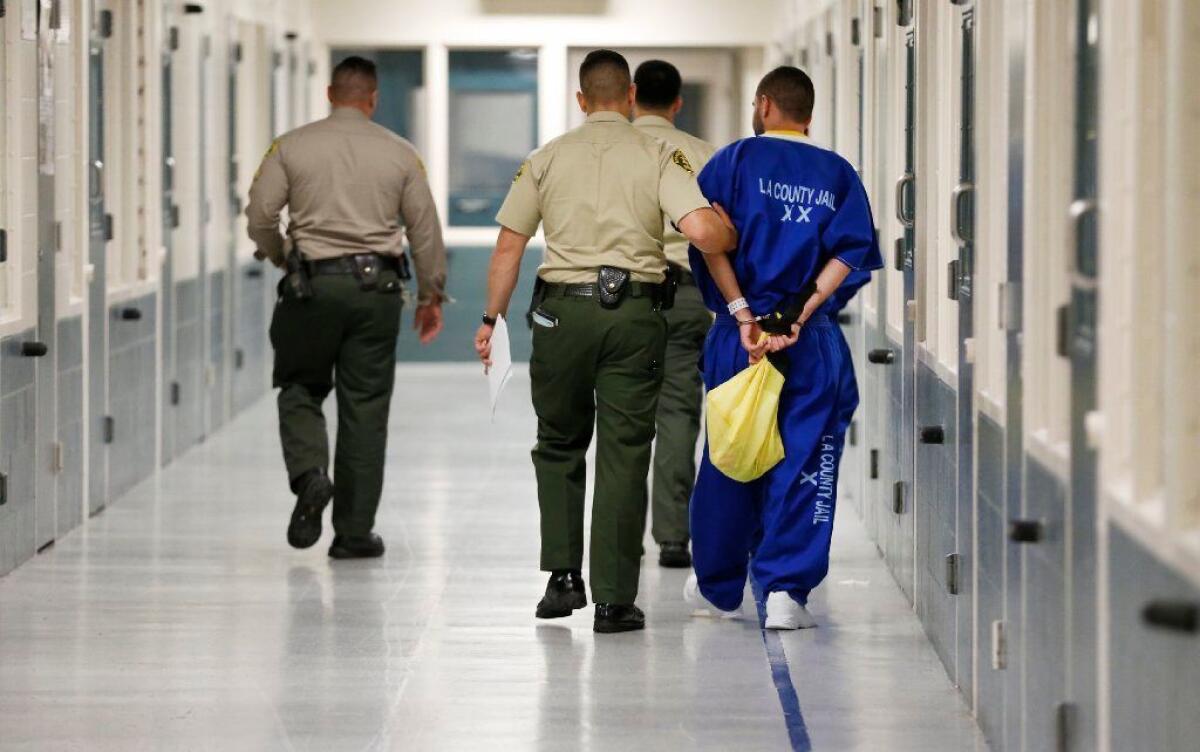L.A. County can help thousands of mentally ill inmates avoid arrest and homelessness, study finds

- Share via
More than 60% of the inmates with a mental illness in the Los Angeles County Jail would be eligible for diversion if there were more facilities capable of providing supportive care, according to a study released Tuesday.
Such a move would save the county hundreds of dollars a day in incarceration costs for each inmate and, for many, end a cycle of being arrested and released, then becoming homeless and getting arrested again, the medical director of the county’s Office of Diversion and Reentry, Kristen Ochoa, said at a news briefing. Thousands of inmates could be taken out of the criminal justice system, she said, citing the study conducted by the nonprofit research agency Rand Corp.
“This is a tool I hope we can use to its fullest,” Ochoa said. “I think all we need right now are resources to increase our capacity.”
About 30% of those in the county jail each day are either in the mental health ward or receiving psychotropic medication. That number stands at about 6,000, after rising steadily in recent years.
The Rand report, which confirmed the findings of an earlier study by the Office of Diversion and Reentry, was conducted to determine how much the county should scale up its community-based mental health services to divert all eligible inmates.
In the four years since the L.A. County Board of Supervisors created Ochoa’s office, it has secured the release of more than 4,400 inmates convicted of felonies or ruled mentally incompetent to stand trial. The cost for housing them is about $70 per day, compared to $600 per day for incarceration, Ochoa said.
The Rand study looked at a sample of the 5,544 inmates with a mental illness to determine whether they would qualify for diversion and whether they met the clinical standard for it. Researchers found that 60.8% would be eligible and another 7.5% might be eligible but would require further assessment.
No overall numbers, either in dollars or in community treatment facilities, were cited in the study, which was limited to one day and did not account for those who might decline diversion or be refused it by a judge.
However, Ochoa conceded, any number “would be a big one.”
The supervisors on Tuesday praised the diversion program, but also expressed reservations about how hard it would be to provide additional mental health facilities.
“This makes sense. The outcomes for people will be so much better,” Supervisor Janice Hahn said. “But I think there’s a lot of hard work out there in real life on actually building this kind of capacity in our communities. I find my biggest frustration currently is just locating shelters for the homeless.”
Supervisor Kathryn Barger, the board chair, said she is focused on building community clinics.
“It is about access to outpatient care,” she said. “Until we do that, diversion is going to fail.”
Retired Judge Peter Espinoza, director of the Office of Diversion and Reentry, said that getting eligible inmates out of jail benefits both their clinical outcomes and the public’s safety.
“Often forgotten is that the vast majority of the people we’re talking about, they’re coming out of the jail eventually — either to us or they’re going to be on their own,” he said. “And we are satisfied that when they come to us, their outcomes are greatly improved and their recidivist behavior is greatly reduced.”
An earlier Rand study of inmates with felony charges who were sent to a diversion program found that 14% of them had a new felony conviction after a year. Espinoza said that number was “unbelievably low” for a “population which is very vulnerable, very sick and on probation.”
More to Read
Sign up for Essential California
The most important California stories and recommendations in your inbox every morning.
You may occasionally receive promotional content from the Los Angeles Times.














